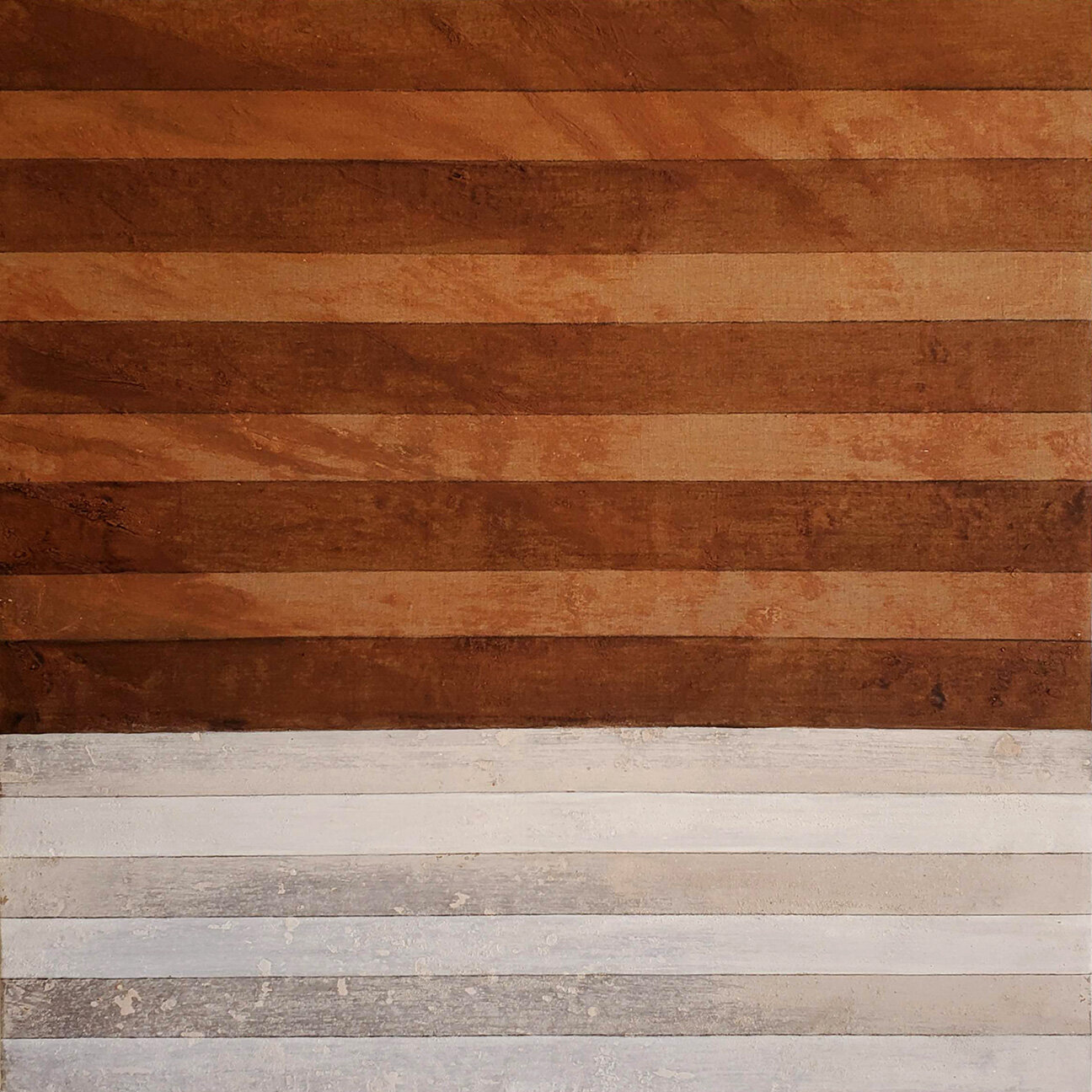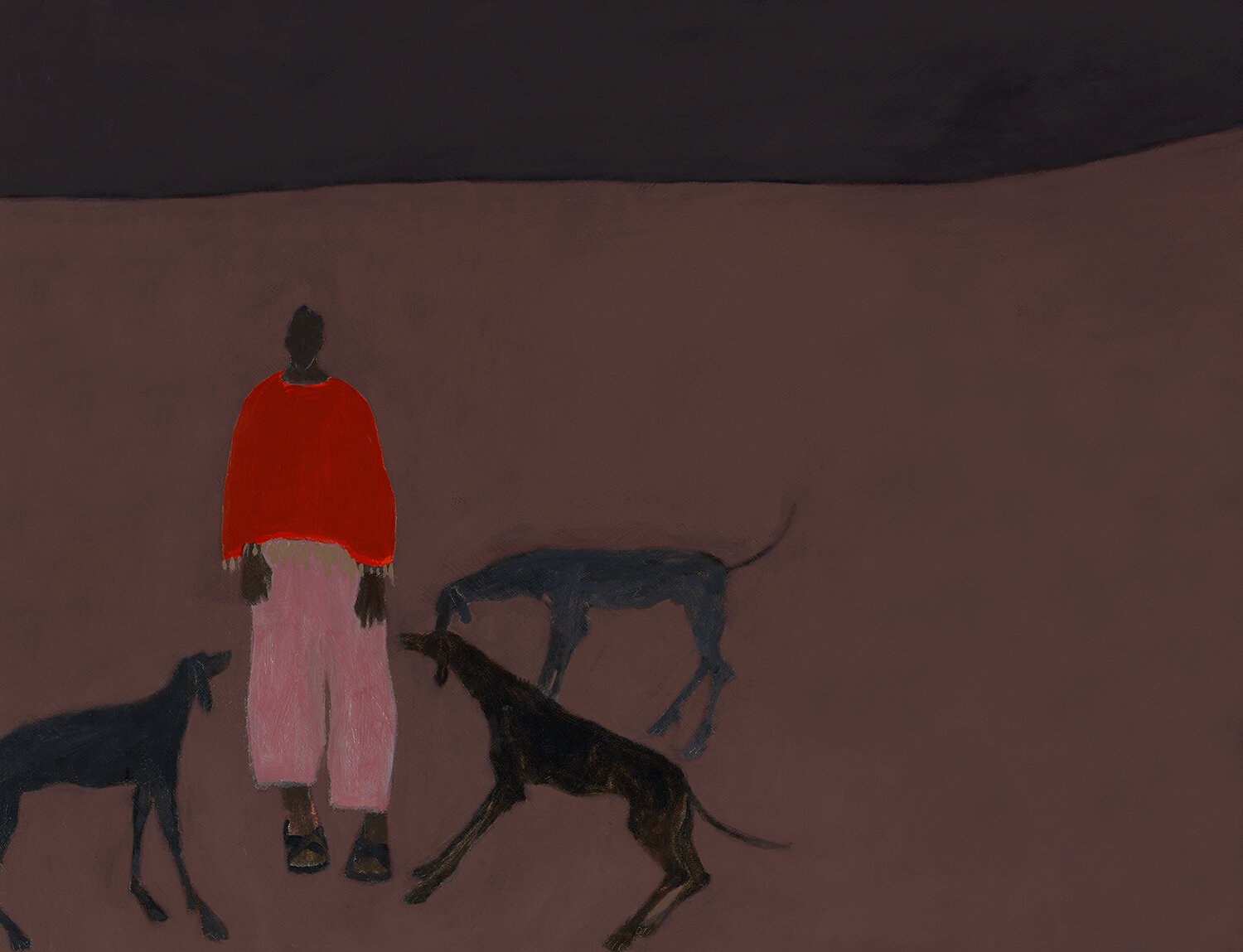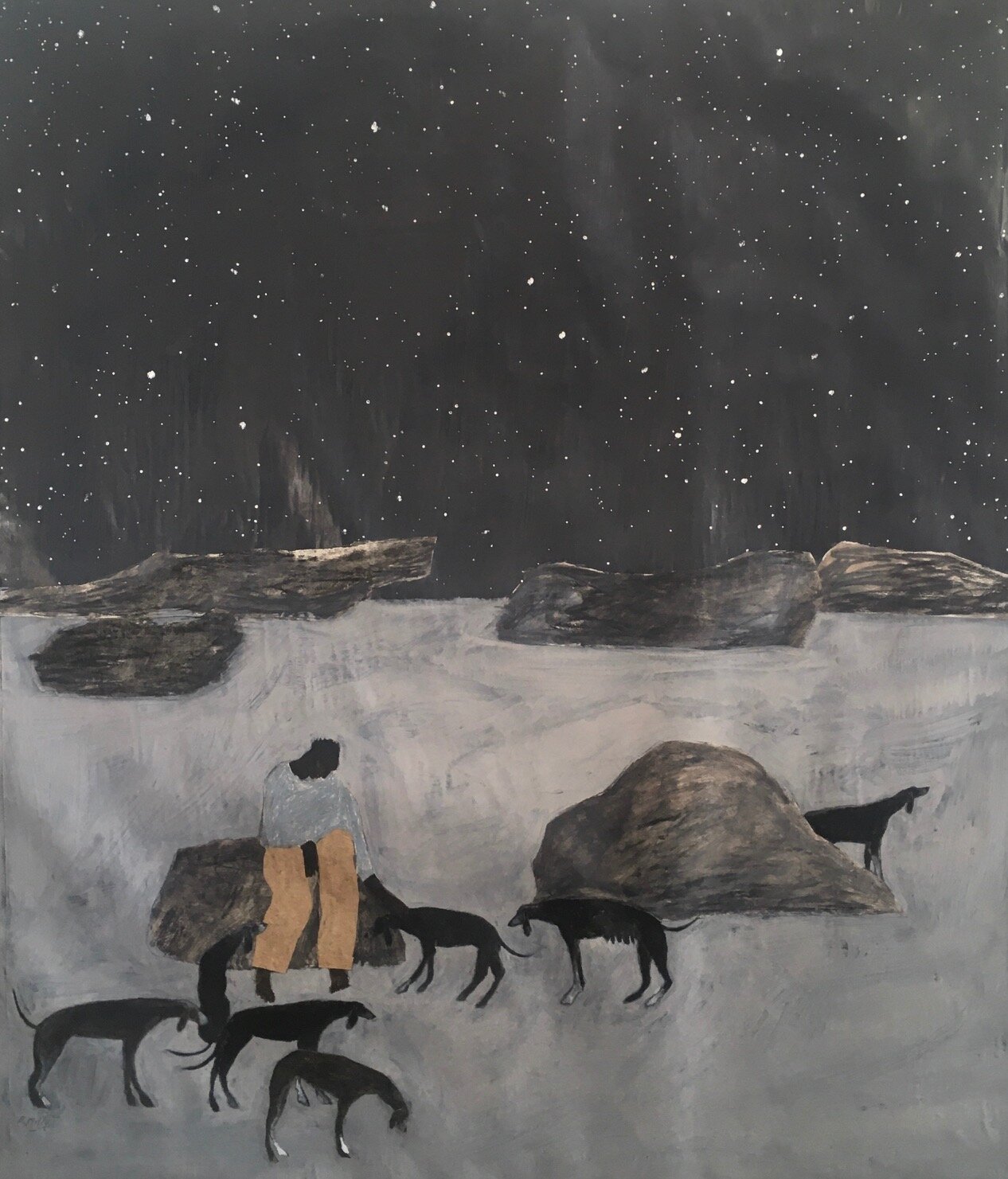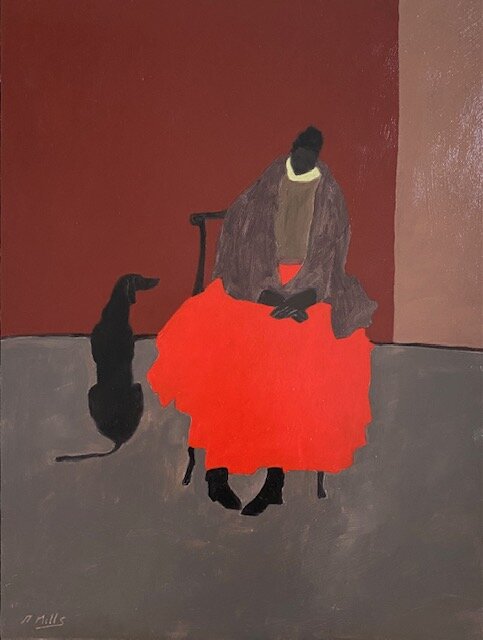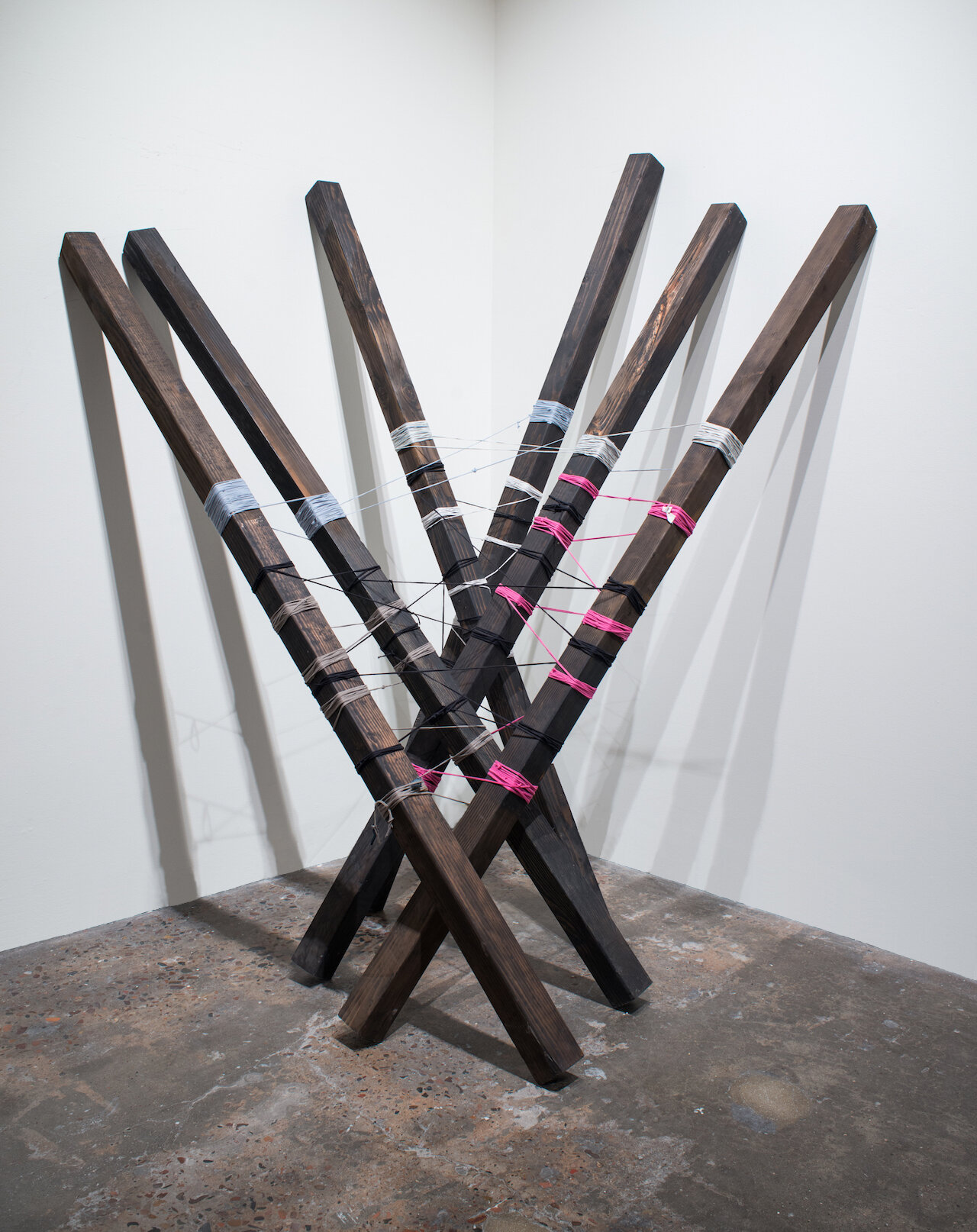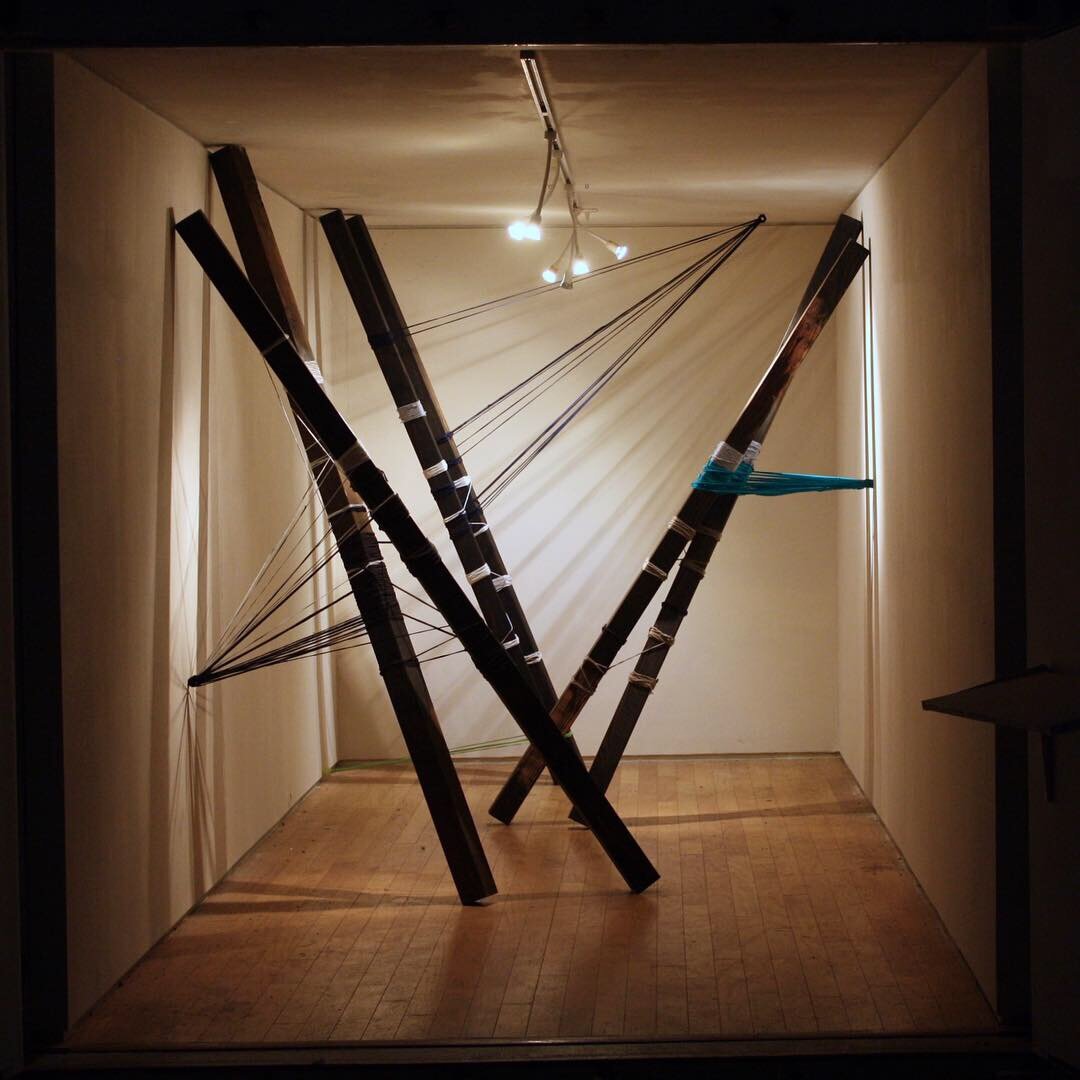Women Artists of the Southwest
Skip to: Gigi Mills, Cydnei Mallory, Ramona Sakiestewa
The artist Yuki Murata
Yuki Murata
Santa Fe, New Mexico
From the outside, all chess matches look alike. But, of course, the limitations offered by a finite set of circumstances can never explain the almost endless variation within. In defiance of the confines of canvas, material, and form, art too has its infinite nuance. Pictures which appear to share a visual kinship can be, at their core, spiritually divergent.
Yuki Murata is, ostensibly, an artist in New Mexico making stripe paintings. She is not, however, an Agnes Martin disciple, neither in her material nor in her approach to her work. While Martin’s spare geometry was inspired by some unknown force beyond the great minimalist’s control, Murata takes direct inspiration from the landscape, in the form of her material: her main source of pigment is dirt, as well as handmade natural inks, derived from turmeric, walnuts, and other plants. And while Martin certainly resonated with the Buddhist philosophy imported to her small circle of artists by her composer friend John Cage, Murata’s clear Japanese aesthetic is in both her blood and her upbringing: her father is Japanese, and though she came of age in New Mexico, her Japanese heritage was always present in childhood, making a lasting impact on Moderngoods, Murata’s line of spare homewares.
Murata’s use of soil as material indelibly ties her work to the place from which it came. “I think of them as core samples,” she says, each stripe representing one of the Earth’s strata. She labels each image with the GPS coordinates of the dirt’s excavation, as if giving you the option to return the painting to its birthplace once it has exhausted its life as an artwork and is ready to be one again with the ground. Something tells me the artist might not object to this act of recycling, based on the answer she gives to the question of whether her work is “archival,” a word of paramount importance to collectors and gallerists, but perhaps less so for artists, who accept decay as a natural part of a work’s life. “In 50 years if the inks fade, that’s part of it,” the artist insists. Murata once shellacked her work, perhaps in an attempt to defy its fragility, but soon realized the added artificial surface sheen removed the viewer from the paintings—and what’s worse, sheared the rough edges off their organicness. “I’ve been interested in putting in the messiness of the making so that you know that it’s handmade,” she tells me.
Knowledge Gathered
In fact, there are many places in which messiness has an invitation into her work, each instance bearing the stamp of place, communicating the work’s physical origin. In Weir Farm (2019), traces of raindrops interrupt the cool horizontal lines of abstraction and drip down the painting’s surface. In a different biome on the other side of the country (at a residency at Resolana in Northern New Mexico), Murata dragged her unstretched canvas behind her through streams and up ravines to allow vestiges of her walks to make their way into her work. Pebbles and other detritus puckered and bulged the canvas once it was stretched over a wood panel, making terrain out of the flat surface, taking the given of the picture plane and creating a more dynamic space out of its intractable smoothness. In both instances, “messy” is a means to (often literally) ground the aspirations of abstraction in reality.
The Place Where the Sun Shines
“It makes sense that [Agnes Martin] could get to a place that was so spare because her life was so spare” Murata notes in awe, calling attention to the artist’s limited diet and empty social calendar. I see a spareness of a different dimension in Murata, who has voluntarily limited her pigments to the palette the land provides. In the 21st century, centering such a connection to the land might seem a stark existence compared to the endless scroll of a life lived on the Internet. She could not have achieved the deep browns of rotting earth without visiting the fecund climes of New England, nor could she incorporate deep reds without being in the landscape of her native state—the variety in her color wheel indicates the spaces through which she has traveled, and none of the places which she has not. But, as is the case within any limited environment, the complexity and nuance of meaning is concentrated therein, a vantage through which the fullness of real life comes into view.
More on Yuki here.
GIGI MILLS
Sante Fe, New Mexico
The artist Gigi Mills
I have never spoken to an artist who has been more interested by—and delighted in—the tricks and quirks of her medium than the painter Gigi Mills. She explains them to me in the context of her work (a blurred edge here, an etched line there), and her words reflect a quiet humility, as if she feels painting was a generous gift she was given. She is self-taught, insisting she was “called” to the medium. But by whom? While she doesn’t specify, it feels to me as if the summons were issued by her foremothers and fathers, painting’s masters from whom she learned the techniques which she employs in her intimate scenes of singular figures in moments of quiet reflection.
Green Nude And Hound. Oil on linen. 16” x 20” Photo by: Orion Studios
The painter’s fascination with technique is centered in her use of color, which might come as a surprise to the casual observer, as her work is rendered in what appears to be a limited, muted color palette. (It was not until recently that planes of yellow and red began to appear in her works, though they are largely still dominated by icy grays and cool purples.) With Gigi Mills, however, what you see is not necessarily what you get. Enter one of those aforementioned masters, the 16th century Venetian painter Titian, from whom Mills learned to layer color. “Titian boasted of 30 to 40 thin layers of oil. I have maybe 10 on some pieces,” she explains. That is to say, though you might not perceive it, beneath the flat expanses of grey and blue which make up many a Mills painting are layers of reds and oranges. While you don’t consciously see them, your brain does, communicating the emotional resonances of those warm colors. “It’s not something that’s obvious,” Mills lets me know, “and it’s not something I need people to know about. I think that they sense it. They pick up whatever quality or value.”
Calling The Hounds/Mexico. Oil on birch panel. 16” x 20” Photo by: Orion Studios.
Just as she doesn’t care if people know there are warm layers beneath gray surfaces, much of her work relies on a similar sense of inner knowing, a knowledge that resides in an unarticulated part of our understanding. “You're aware of feeling something, but you’re not sure what,” she says by way of explaining her paintings’ spare scenes. If you have trouble putting words to how these paintings make you feel, fear not—it’s not even clear if the artist herself knows “what” it is, as whenever she speaks of her work she offers her interpretation, as if she has just come upon these paintings for the first time.
Calling the Old Hounds. 54” x 38”. Oil, paper, crayon and graphite on paper. Photo by G. Mills
What’s happening in the nocturne Calling the Old Hounds, for example? The artist describes the scene: “They’re all old dogs. They used to be hunters, I don’t think they’re huntin’ very much any more,” adding, “This loving man is tending to them... the owner of them? I don’t know.” Though she hasn’t quite figured out the relationship the man has with these dogs—whether master or friend—the artist speaks with a discernible warmth. After all, for Mills not knowing is far from limiting, but rather frees her to endlessly imagine. “A night sky” like the one above the lone hunter “always...hold[s] possibility,” she muses. “I think that’s what night skies mean to me. Endless possibilities. It’s so unknown and unknowable to most of us, that we can expect anything.”
Dogs, cows, and horses—which appear often in Mills’s work—are a cathartic supplement to the night sky, a repository not of hope, but rather of angst. In other words, animals feel so that we don’t have to feel as much. “A lot of animals carry our emotional burdens,” the artist says. This is true for Mills’s own dog, Birddog, who often shows up in her paintings (though he is sadly no longer alive). She speaks of his apparitions as she does many of her subjects—with a passivity that suggests his appearance is by his own will, not hers. “Birddog has shown up again,” she’ll say, pointing to a painting with a smile. If pets do indeed share our struggles, the painted Birddog appears to act as he did in life—holding on to the artist’s fears so that her burden might be easier. Whether or not we know the animals within these works, we can let her paintings do the same for us.
The Red Skirt. 16” x 13” Oil on birch panel. Photo by G. Mills
* * *
One evening before her most recent show opened, Mills lay down on the gallery floor, beneath Night Sail/Sea, Sky, On Coming Wave, a large scale collage of the sea at night. There she lay looking up into the depths of the work’s paper sky, as if it were the endless expanse of our universe.
Life is something that flows through us, a current of energy vibrating at various frequencies—somber, hopeful, melancholy, weary—and art is a place to put those feelings when they get to be too much, a channel to divert the flow. When the world is too much with us, the paintings of Gigi Mills offer that relief.
More on Gigi here.
Cydnei Mallory
Phoenix, Arizona
More and more frequently I have found that my conversations with artists touch on a concern about the environmental impact of their work. As sacrilegious as it feels to say given our belief that art exists on a heavenly plane, art is, at the end of the day, just stuff.
The artist Cydnei Mallory
“50 Women Project” artists like Helen Mirra address this by making less of it, while Julia Christensen, in her book Upgrade Available, insists upon a realignment in society towards the modular and the refurbished. Cydnei Mallory, an installation artist based in Phoenix, Arizona, has found a viable solution to similar concerns, taking a position somewhere between Mirra’s and Christensen’s: using the same materials—six four by fours, a length of rope, and a mass of hairnets among them—she fashions and refashions her installations, building on their meaning by reusing materials.
The length of rope, which currently resides in a ball in the artist’s apartment (“It’s art, it’s just not tied up, she says of this piece), has been employed as variously as in a room length installation, as well as knotted and tied in a hanging mobile. Mallory insists that this material cannot be altered—wherever it is installed in the future, it will appear as it is: she will neither shorten it, nor unravel it, nor cut it into pieces, as its consistency across time and place are essential to its meaning.
Six four by fours, three ways
Not only do these restrictions insist that the artist be creative with her iterative installations, but they also highlight the wide possibility inherent within certain types of materials, particularly those associated with craft. Rope, and its daintier cousins, yarn and thread, are the basic building blocks of our inhabited world. If you don’t believe me take a look at what you’re wearing. Unless you’re reading less than half in the buff, you’re wearing something knitted or woven.
Though craft’s universality is undisputed, pernicious associations with gender remain. Why is a knitted garment an example of craft, associated with women, while a knotted halyard is male? This critique is most succinctly communicated in Mallory’s Untitled, a piece of knitting to which is attached both a yarn ball and a sailor’s knot, suggesting that when interrogating the essence of textiles, the assignation of gender is arbitrary.
When talking to Mallory I couldn’t help but think of the concept of sympathetic magic (which, if you’ve been following the “50 Women Project” for long, you will remember was also a concern for the sculptor Linda Lopez), which insists that an object contains within it the story of its life, almost like a physical memory. Mallory’s work embraces this concept, and if her audience does not know of her work’s previous lives, she certainly does.
This is, in many ways, a radical approach to art in the age of mechanical reproduction. The art piece, rather than losing its aura in its reiterations, gathers it, becoming greater than itself over the course of its life. “If this piece were ever purchased or ruined,” the artist says, “I don’t know if I would go out and buy six more,” as the new pieces would lack that accumulated je ne sais quoi.
Despite her innovations, Mallory is not, however, unmoored from the history of art. Ropes (and the repetitive labor associated with them) were of interest to the artist Eva Hesse, and certainly the dead-weight heaviness of some of Mallory’s hanging pieces recall the post-minimalist’s work, while the use of hairnets in both installation and performance feels like an homage to the pioneering Senga Nengudi, who installed sand-filled pantyhose in the gallery, which she would periodically activate with dance. In Mallory’s Weight, hairnets are stuffed not with sand, but rather are filled to bulging with other hairnets to create gauzy sacs, which the artist has gathered in a mass that oozes from the ceiling and almost reaches the floor in a suspended column.
In analyzing Mallory’s work it is helpful to analyze her material structurally. A thread is made from a number of fibers twisted around themselves, while those fibers are also composed of fibers twisted in the opposite direction. Depending on the gauge of the thread, these fibers might also be composed of twisted fibers, and so on and so forth, creating a mise-en-abyme, which threatens to envelop us if we lean in too far.
In a performance piece the artist evoked a similar uncanny endlessness by layering numerous hairnets over her face and head, which she peeled away one by one to reveal another beneath. After washing each (in the three step process of wash, rinse, sanitize maintained in industrial kitchens) she assembled the discarded pieces in a honeycomb pattern, which itself mimicked the hairnets’ own hexagonal weave.
Untitled, 2013
By using the honeycomb to evoke the busy, anonymous, and replaceable worker bees, Mallory makes a statement about labor and the ways in which we erase individuals on the bottom rungs of the economy in favor of the functioning whole. (The color of the hairnets—mostly browns and blacks—implicitly evoke the black and brown bodies who most often exist within these roles.)
Untitled, 2013
There are two ways to dignify the individual—one is to lift him up, celebrate him for his uniqueness. The other way is to insist we are all equal, that there is no plane of existence where one object or person can exist as superior. Mallory dignifies the individual not only by giving the art object a mutable life, thereby removing it from its pedestal, but by laying bare the systems which keep the hive humming.
Though it has always had its voice, Mallory’s art speaks to a moment which has finally recognized the worker as “essential.” As her work continues to morph across time, let us not forget the truth of this message.
More on Cydnei here.
Ramona Sakiestewa
Santa Fe, New Mexico
The artist and designer Ramona Sakiestewa
Understanding the value of museum spaces, specifically for the people who use them, is of vital importance to artist and designer Ramona Sakiestewa. The artist has extensive experience in architectural design (a discipline responsible for the parts of architecture that are not the building, but are contained by it), specifically for cultural institutions. Her projects range from the National Museum of the American Indian on the National Mall, as well as the First Americans Museum in Oklahoma City, to the Tempe Performing Arts Center in Arizona. While Sakiestewa also works as a textile artist, printmaker, and painter, she says she particularly loves the “architectural work because you can work in a lot of mediums and at a bigger scale.” In some ways, it’s the place where her diverse skills meet.
Handwoven theater curtain depicting four ravens and the Moon along with images of a winter night of ice and mist in the Smithsonian’s National Museum of the American Indian, Washington, DC.
There’s so much critique of the capital-M Museum these days that one might wonder why there are new ones being established every year. In light of recent uproar over museums’ poor representation of their increasingly diverse audiences, how does Sakiestewa avoid repeating the mistakes of past institutions to ensure the spaces she helps build honor those for whom they are created? Well, first of all, “you have to do a lot of interviewing,” she says. “I feel like I do my best work when I know the least about something,” as an open mind is essential to hearing what those whom she interviews value most. An inability to understand the people you are working with can end up in chaos, as the artist learned on her visit to Erbil, Iraq, where she was working to create a (not yet extant) government building. “People [in Iraq] are very tribally based,” the artist explains, “so suddenly I understood why Americans had failed in that country because we were busy trying to sell them on democracy... They default to their own tribal constraints.”
Komatke Healthcare Center
The project to create the Chickasaw Cultural Center for the Chickasaw Nation, whose lands stretch across much of central Oklahoma, bore some striking similarities to the Iraq project. In addition to their tribal associations, both groups have “lost a lot of their own cultural patrimony,” notably at the hands of the same people—the American government. Within that context, Sakiestewa’s project was to create a dynamic institution in which both past and present could coexist. (The artist herself is not of the Chickasaw Nation, but rather of Hopi descent.)
But how to build it? In effect, Sakiestewa was tasked with making the anti-museum, a concept whose origins might be found in the Western Museum—which takes the contents of the (dominated, colonized) world and brings it home—and turns it on its head. The Cultural Center is a place for its members not to find the world, but to find home, as so much of their cultural heritage has been purged from their lives. Instead of walking in and seeing unfamiliar objects from a foreign land, tribal members are meant to recognize their surroundings and feel strengthened by them.
I by no means want to suggest it is not a space of discovery, however. An extensive library includes a comprehensive archive on the tribe’s own history, and a gallery for contemporary art is included on the grounds. But neither is it a place exclusively of history—potlucks and other events are frequently held (in non-pandemic times), so that the tribe’s story can continue to be written, shared, and collectively built upon.
Above and above left: Floor designs from traditional basket patterns for the Komatke Health Care Center, Gila River Health Care Corporation, Chandler, Arizona.
In many of her projects, Sakiestewa uses architecture as a way of celebrating Native achievement on a grand scale. The Smithsonian’s National Museum of the American Indian is itself a testament to Native advancements in astronomy. An installation by the artist Charles Ross, which illuminates the building’s lobby every year on the solstice, is an homage to that knowledge.
“It’s important for me to convey to people that we were not just living in mud huts somewhere collecting nuts and berries,” the artist says wryly. “We were watching the heavens for planting cycles, hunting, weather. A lot of science and technology happened based on astronomical observation that had to do with our well being.”
Sakiestewa’s fascination with the heavens also exists on the scale of her studio. Her nebula tapestries, some of which are currently on view in the “Hearts of Our People: Native Women Artists” exhibit, which was organized by the Minneapolis Institute of Art and is on view at the Philbrook Museum until January, were born from images sent back to Earth from the Hubble Space Telescope. The inherent painterliness of these stellar phenomena immediately spoke to the artist, and the swathes of color layered like watercolors inspired her to translate this diaphanous sight into cloth. The question became, then—how does one create the illusion of layers within the single plane of fabric?
Nebula 17, wool tapestry 18” x 19”
The nebula, with its overlapping space clouds, beautifully illustrates the objectness of weaving. Consistent with the traditions of weaving from the American Southwest, the works are finished on both sides, making neither the dominant one. Though weavings result in a single pliable plane, they are three dimensional objects, in which colors are physically entwined and layered. Though the extent of the image’s depth is largely illusionary, the threads do duck in and out of sight, in the way clouds of star dust mingle with each other.
After this series was completed, the artist moved on from her weaving practice, as she calls these tapestries, “the zenith of the best work I could do.” Since then she has taken on another challenge—painting and printmaking. Of this new discipline she says, “I don’t feel like I’ve mastered it. I haven’t gotten to a level that’s completely satisfactory. There’s still more I can do.” Though this new work appears a departure from her previous oeuvre, it is in line with her ethos. She herself said it best: “I feel like I do my best work when I know the least about something.”
More on Ramona here.


